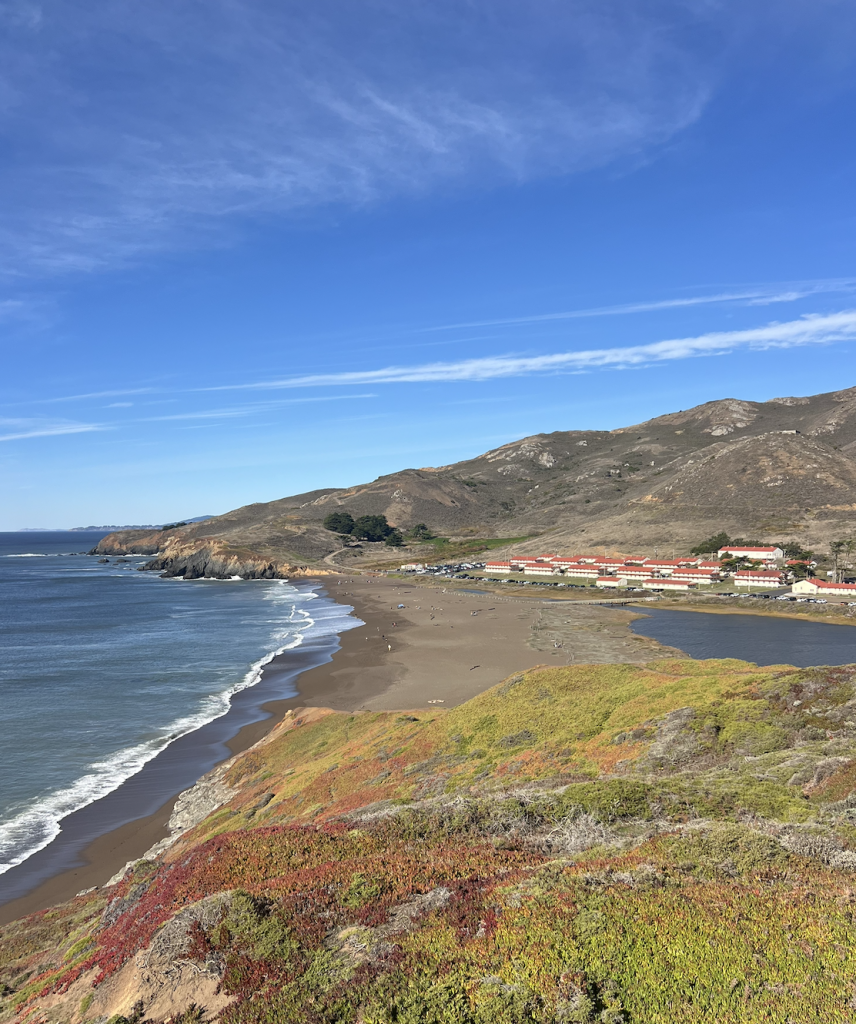The Natural World as Property
Image Description: Picture of the Marin headlands coast with out-of-use military buildings in the distance.
My brother and I admire the homes as we make our way through the sand. We found a little side street that quietly jutted out from PCH, unassuming and maybe even unnoticeable to the cars racing by or the tourists in search of more flashy things. After making a run for it across the PCH because we didn’t want to walk all the way to the stoplight, we stumbled through the sidewalk and onto the beachfront. The beach does not feel like a beach so much as a backyard for the houses that loom over the shore. I immediately got the sense that we weren’t supposed to be there, like we were intruding onto someone’s private property. There was probably about 20 feet from the perimeters of the homes to the beach itself and their shadows seemed to stretch all the way onto the water. The homes were beautiful, beyond beautiful. They did not fit a uniform, HOA mandated style. I feel like maybe that is the true marker of wealth, not the uniform planned communities where all of the homes look the same but the neighborhoods where homes can be works of art. They were each unique but pristine in their own right. There were a lot of stark modern homes, my least favorite, with their concrete walls, moody color schemes, and sheets of glass. These homes feel souless to me. Sterile. They remind me of what the world would look like if I was living in a company town. But there weren’t as many of these as I would have anticipated. A lot of homes seemed like they were meant to replicate the kind of waterfront homes that you would see in the Northeast and some that seemed to be reincarnations of the mid-century modern style. There were a few that were meant to mimic the Spanish colonizer style that LA is so well known for.
Walking along the coast or maybe through the backyards or maybe both, I began to see that the homes themselves represent wealth in a material sense because they are composed of physical materials and the fruits of one’s labor, their use value. But these elements only make up a small portion of their value. The true value comes from their location on the coast: their proximity to the ocean and the access to the beach their location provides to those who occupy the space. The value of the homes is derived from the ability to provide the inhabitants with ease of access to the natural world, ease of access to the expansive oceanic abyss unmarked by human civilization. The obvious oxymoron is that this bliss and unmarred enjoyment of the natural world is dependent on one’s ability to pay for this access. Even more ironically, the reality is that the need for spaces to escape into to avoid the pain and exhaustion of daily existence is created by the same institutions that privatize these spaces. True wealth is the ability to escape, the ability to enjoy the natural world, which we all have a right to as inhabitants of the earth.
But because of the privatization of property, nature is not accessible to most people. Take Los Angeles for example, public transportation is not effective in most cases because the auto industry has limited the infrastructure in the name of selling more cars. Public transportation in Los Angeles is an especially ineffective way to access the beaches that have become a defining feature of its cultural mythos. In order to access these spaces, most people need a car because most people cannot afford to live close to them.
As we continued our trek, it no longer felt like we were intruding in someone’s backyard because it quickly became obvious that no one actually lives in any of these homes. It wasn’t readily apparent at first until the emptiness that radiated from them progressed from a nagging feeling in my gut to an overwhelming sensation. There was no sign of life on their sprawling decks. No children’s toys. No beach towels left to dry. Not even any sand haphazardly scattered after a quick dip in the ocean. The only human activity was from the people that were doing minor construction on some of the homes. It almost felt like we were wandering amidst a graveyard. The large houses may as well have been tombstones, to whom exactly I don’t know. A place where people once occupied and loved but no longer do. Or that we were among these great relics of the past. Even the houses that were meant to feel homey seemed to lack a humanness that made them seem almost uncanny. We deduced that most of these homes are owned by people that don’t live there anymore or are rental properties.
As we walked, I couldn’t take my eyes off of the homes despite the fact that the beach is my favorite place in the world and I typically cannot take my eyes off of the coast. I couldn’t shake this feeling of sadness. I turned to my mom and said, “Isn’t it sad that these are just rental properties? That real people don’t get to live here?”
She responded, “Well, can real people even afford to live here?”
Under capitalism, property becomes human. The value of these homes becomes akin to that of a life. Walking along the coast, I could see this. Each home deliberately constructed with a specific aesthetic in mind, almost as if they are meant to reflect specific kinds of people. I imagined what it would be like if these giant constructions morphed into humans and made their way across PCH and into the city, to make lives of their own. There was a home with stark white walls with dark blue detailing around the perimeters and bright spots of sanded down vibrantly colored stones lodged sporadically into the walls. The home seemed as if it was intentionally mimicking the style of homes along the coast of Greece. It felt as if the soul of a whale or perhaps a mermaid was yearning for the day when its soul is free from the confines of contractual obligation or shareholder value or a mortgage. It will slip into the sea again and become one with the salty water, the bubbling foam, and all of the other creatures. But what of the stone that makes up the walls, the blue paint, the wood of the door? When will all of these elements come back from whence they came? Capitalism distorts the spirit of the Earth until it becomes a cruel imitation of what it could be.
A few weeks earlier when I was visiting my family in the Bay Area, we drove out to the Marin headlands. Because San Francisco stares directly into the face of the Pacific ocean, it was once rife with naval activity during World War II. The landscape is scattered with old barracks and buildings that haven’t been abandoned necessarily but their legacy is unshakeable in a way that feels similar to a haunting. I can’t imagine them being able to serve any other function, don’t think I would ever be able to let go of implications that mark it’s past. As we walked through the hills I felt as though I could hear the heavy tread of boots on the gravel or the snickers of boyish laughter of those that had walked here before me. Even years later, the landscape will never be free from the mark of the military and all the damage it has caused.
The beaches in Northern California are very different from Southern California. They aren’t easily accessible, the ground is rough and rocky, and the water is too cold to comfortably swim in even in the summer months. I think that you really have to like the beach in order to appreciate the beaches of Northern California. The coastal weather of Northern California is frequently gloomy and almost always cold. Looking out into the ocean with my back to the freckling of military buildings against the otherwise picturesque hillside, I felt a haunting similar to the one I had felt in Los Angeles. In the case of the Los Angeles beaches, the coast has been bought up by real estate developers intending to make money from the buying and selling of private property. But the coastline of the San Francisco Bay seems to be haunted by a different spectator of capitalism, the military industrial complex and the United States empire’s unquenchable thirst for land that is not their own.





